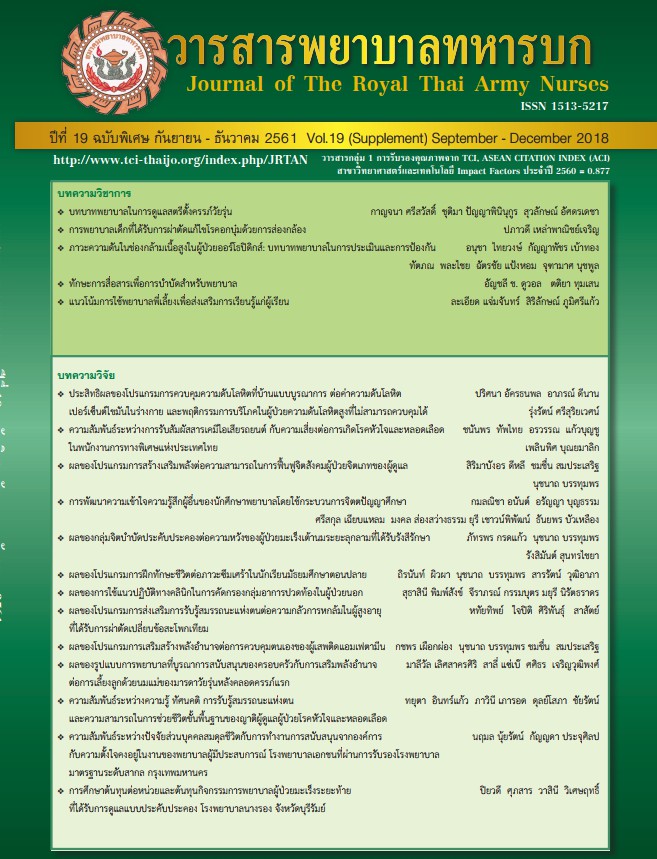The Relationship Between Engine Exhaust Exposure And Risk of Cardiovascular Diseases Among Workers In Expressway Authority of Thailand
Keywords:
Expressway Staff, Peripheral Blood Flow, Chemicals, Car Exhaust, Risk of Cardiovascular DiseasesAbstract
This study aimed to investigate the relationship between engine exhaust exposure and risk of cardiovascular disease among workers in Expressway Authority of Thailand. This research is a cross-sectional survey. Subjects were 177 expressway authority employees. Data were collected by questionnaire, an assessment of risk of cardiovascular disease was conducted by means of using the second derivative finger photo-plethysmogram (SDPTG). Relationships were analyzed using Pearson’s correlation coefficient and Multiple Regression Analysis The findings in this study indicated that SDPTG-AI was -0.51 ± 0.32, and exposure to car exhaust was found to be correlated with the risk of cardiovascular disease among workers in Expressway Authority of Thailand, which was statistically significant (r = 0.132 p-value = 0.035) after control of personal factors and health behaviors. Based on the results of this study, were the suggestions for the agencies to promote healthy behaviors such as weight control, sodium-controlled diet and Working behavior such as the use of personal protective equipment to reduce the risk of cardiovascular disease.
References
2. Strategy and Planning Division, Office of the Permanent Secretary. Strategy, metrics and Storage guidelines Ministry of Public Health. Bangkok: Samcharoen Panich Co., Ltd; 2016. (in Thai)
3. Expressway Authority of Thailand. Annual report 2016. Bangkok: Expressway Authority of Thailand. (in Thai)
4. Bureau of Non Communicable Diseases, Department of Disease Control, Ministry of Public Health. Guidelines for Assessment of Cardiovascular Risk. Bangkok: WVO Officer of Printing Mill, The War Veterans Organization of Thailand Under Royal Patronage of His Majesty the King; 2014. (in Thai)
5. Jirojanakul P., Nipathatapong S, Keinwong T, Pipatsombat P, Rowsathien N. Cardivascular Risk Factors in a Cross-Sectional Study. Thai Journal
of Cardio-Thoracic Nursing 2013; 24(1): 44-55. (in Thai)
6. O’Donnell CJ, Elosua R. Cardiovascular Risk Factors. Insights From Framingham Heart Study. Revista Esponala Cardiologia 2008; 61(3): 299-310.
7. Diene E, Fouquet A, Esquirol Y. Cardiovascular diseases and psychosocial factors at work. Archives of Cardiovascular Disease 2011; 105: 33-39.
8. Solomon A. et al. Induction of platelet aggregation after a direct physical interaction with diesel exhaust particles. Journal of Thrombosis and
Haemostasis 2012; 11: 325-334.
9. Jeng HA. Polycyclic aromatic hydrocarbon-induced oxidative stress and lipid peroxidation in relation to immunological alteration. Occupational & Environmental Medicine 2010; 68(9): 653-58.
10. Everett CJ. et al. Association of urinary polycyclic aromatic hydrocarbons and serum C-reactive protein. Environmental Research 2009; 110:
79–82.
11. Silpasuwan P. Occupational Health Nursing: Concepts and Practice. 2015 Bangkok: Chuanpim Printing. (in Thai).
12. Wayne WD. Biostatistics Afoundation for analysis in the Health Sciences. New Jersey: Wiley; 2005.
13. Ilar A. et al. Myocardial infarction and occupational exposure to motor exhaust: a populationbase case-control study in Sweden. Occupational Epidemiology 2014; 29: 517-525.
14. Phaktongsuk P. & Apakupakul N. Validation and modification of Karasek job stress questionnaire in Thai population. The Thailand Research Fund; 2005. (in Thai)
15. Otsuka T, Kawada T, Katsumata M, & Ibuki C. Utility of Second Derivative of the Finger Photoplethysmogram for the Estimation of the Risk of Coronary Heart Disease in the General Population. Circulation Journal 2006; 70: 304-310.
16. Kaewboonchoo O. et al. Blood Lead Level and Cardiovascular Risk Factors among Bus Drivers in Bangkok, Thailand. Industrial Health 2010; 48: 61–65.
17. Naknoi S. Effects of Exposure Prevention Behavior Promoting Program to Pesticides on Peripheral Blood Flow in Rice Farmers. [Thesis in Community Nurse Practitioner]. Bangkok; Faculty of Graduate Studies Mahidol University; 2016. (in Thai)
18. Alshaarawy O., Elbaz H. A. & Andrew M. E. The association of urinary polycyclic aromatic hydrocarbon biomarkers and cardiovascular disease in the US population. Environment International. Environmental International 2016; 89(90): 174-178.
19. Nipaspong K. Factors Related to Health Status of Firefighters in Bangkok. [Thesis in Public Health Nurse]. Bangkok; Faculty of Graduate Studies Mahidol University; 2013. (in Thai)
20. Yaruang N, Sukonthasarn P. Occupational Safety Behaviors and Health Status Among Rice Farmers in Chiang Rai Province. Journal of The Royal Thai Army Nurses. 2016; 17(2) : 163-174. (in Thai).
Downloads
Published
How to Cite
Issue
Section
License
บทความหรือข้อคิดเห็นใดใดที่ปรากฏในวารสารพยาบาลทหารบกเป็นวรรณกรรมของผู้เขียน ซึ่งบรรณาธิการหรือสมาคมพยาบาลทหารบก ไม่จำเป็นต้องเห็นด้วย
บทความที่ได้รับการตีพิมพ์เป็นลิขสิทธิ์ของวารสารพยาบาลทหารบก
The ideas and opinions expressed in the Journal of The Royal Thai Army Nurses are those of the authors and not necessarily those
of the editor or Royal Thai Army Nurses Association.





